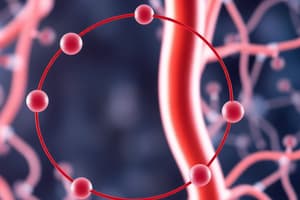Podcast
Questions and Answers
What is the primary function of the tricarboxylic acid cycle?
What is the primary function of the tricarboxylic acid cycle?
- It generates ATP by oxidizing carbon skeletons. (correct)
- It converts glucose into pyruvate.
- It incorporates oxygen into metabolic processes.
- It synthesizes fatty acids from carbohydrates.
Where does the oxidative decarboxylation of pyruvate occur?
Where does the oxidative decarboxylation of pyruvate occur?
- In the nucleus.
- In the cytoplasm.
- In the mitochondrial matrix. (correct)
- In the inner mitochondrial membrane.
Which enzyme is responsible for the first step in the conversion of pyruvate to acetyl CoA?
Which enzyme is responsible for the first step in the conversion of pyruvate to acetyl CoA?
- CoA transferase.
- Dihydrolipoyl transacetylase.
- Pyruvate dehydrogenase. (correct)
- Dihydrolipoyl dehydrogenase.
How many coenzymes are involved in the pyruvate dehydrogenase complex?
How many coenzymes are involved in the pyruvate dehydrogenase complex?
Which of the following is NOT a component of the pyruvate dehydrogenase complex?
Which of the following is NOT a component of the pyruvate dehydrogenase complex?
Which coenzyme is specifically required for the activity of E1 in the PDH complex?
Which coenzyme is specifically required for the activity of E1 in the PDH complex?
What is the role of CoA in the pyruvate dehydrogenase complex?
What is the role of CoA in the pyruvate dehydrogenase complex?
Which of the following substances is produced from pyruvate before entering the TCA cycle?
Which of the following substances is produced from pyruvate before entering the TCA cycle?
What is the primary purpose of transporting pyruvate into the mitochondrion?
What is the primary purpose of transporting pyruvate into the mitochondrion?
Study Notes
Tricarboxylic Acid Cycle (TCA cycle)
-
The TCA cycle is the final pathway for the breakdown of carbohydrates, amino acids, and fatty acids.
-
The cycle occurs entirely in the mitochondria.
-
The TCA cycle converts carbon skeletons to CO2.
-
The process of oxidation during the TCA cycle provides energy for the production of ATP in most animals.
Oxidative Decarboxylation of Pyruvate
-
Pyruvate, the end product of aerobic glycolysis, is transported into the mitochondria via a specific transporter.
-
Once inside the mitochondrial matrix, pyruvate is converted to acetyl CoA by the pyruvate dehydrogenase complex (PDH complex).
-
The PDH complex is a multienzyme complex consisting of three enzymes: pyruvate dehydrogenase (E1), dihydrolipoyl transacetylase (E2), and dihydrolipoyl dehydrogenase (E3).
-
The PDH complex utilizes five coenzymes:
- Thiamine pyrophosphate (TPP) for E1.
- Lipoic acid and CoA for E2.
- FAD and NAD for E3.
Studying That Suits You
Use AI to generate personalized quizzes and flashcards to suit your learning preferences.
Description
Explore the critical processes of the TCA cycle and the oxidative decarboxylation of pyruvate. This quiz covers key concepts such as the mitochondrial functions, enzyme complexes, and coenzymes involved in energy production. Test your knowledge on metabolic pathways essential for cellular respiration.



